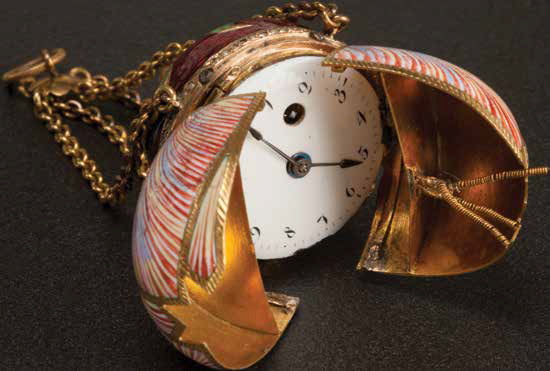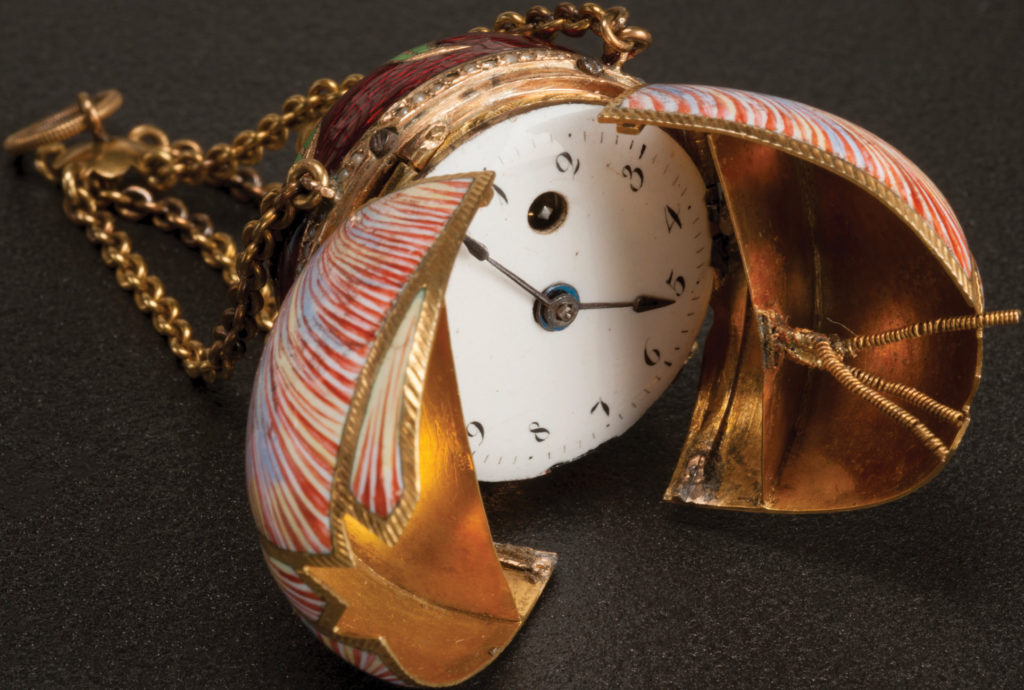
Watch by Peter Comtesse, Vienna, Austria, c. 1875–1900. Inscribed “Peter Comtesse in Wien” on the movement. Silver gilt, enamel, steel; height 2 ¾, width 1, depth 1 inch. All objects illustrated are in the Munson-Williams-Proctor Arts Institute Museum of Art, Proctor Collection. Photograph by Richard Walker.
Although today watches are worn primarily on the wrist, that has not always been the case. From the last third of the sixteenth century until the middle of the seventeenth and from the last quarter of the eighteenth through the nineteenth, watches were created in special shapes that were hung around the neck, at the waist, or suspended from a brooch pin. The dial on these timepieces—today known as form watches—was hidden and became apparent only after opening the cover or lid. They were jewels to be enjoyed on one’s person as well as tellers of time.
Watches were made of a variety of materials, including base metals, gold, silver, or semiprecious stones such as rock crystal. In the eighteenth and nineteenth centuries, gold was the preferred metal for form watches. The manufacture of these watches required skilled artisans, who were frequently employed at different workshops specializing in particular aspects of the timepiece. The process began at the foundry, where gold, silver, and metals were smelted to produce an alloy of the required quality and color. This material was rolled into at sheets that were cut to the appropriate size for the piece and then spun on a lathe to form the shape. Next, the case was sent to the appropriate department to be repoussé chased and/or engraved, or it could also be engine-turned, which entailed an artisan using a special machine to create geometric patterns. Applying translucent enamel to the surface was the last step, resulting in vivid colors enhancing the case. Most of the watches in the collection of the Munson-Williams-Proctor Arts Institute were created in the eighteenth and nineteenth centuries in central Europe.
While the nobility, for whom jewelry was primarily made, tended to be conservative, the growing merchant classes were more amenable to change and to new ideas represented by the technological advances in timepieces. Form watches offered a particularly fascinating marriage of beauty and usefulness. The watch industry excelled at providing not only accurate timekeeping but also creating interesting and innovative watches for a clientele eager for the latest designs.
The shapes of form watches were drawn from a range of subjects, including flora and fauna and objects of everyday life. Flowers such as tulips, pansies, roses, daisies and floral baskets were popular, while some watches took the shape of apples, cherries, strawberries, shells, birds, beetles, or butterflies. As music began to dominate the popular arts in the late eighteenth and early nineteenth centuries in Europe— with composers such as Beethoven, Shubert, and Chopin creating their masterpieces—musical instruments became a frequent theme. Anything that was enchanting or unusual became an inspiration and was re-imagined into a precious bibelot.
Form watches are, perhaps, simply bibelots, yet the design, workmanship, and timekeeping of these treasures continue to inspire and amaze us today.
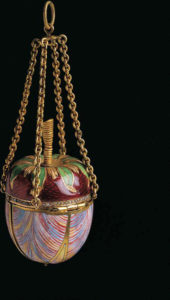
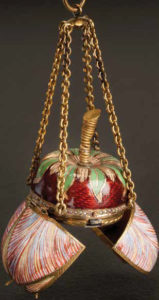 Watch by Peter Comtesse, Vienna, Austria, c. 1875–1900. Inscribed “Peter Comtesse in Wien” on the movement. Silver gilt, enamel, steel; height 2 ¾, width 1, depth 1 inch. Photography by John Bigelow Taylor (left) and Richard Walker (right).
Watch by Peter Comtesse, Vienna, Austria, c. 1875–1900. Inscribed “Peter Comtesse in Wien” on the movement. Silver gilt, enamel, steel; height 2 ¾, width 1, depth 1 inch. Photography by John Bigelow Taylor (left) and Richard Walker (right).
This tulip-shaped watch conceals the movement inside the calyx. The petals are enameled in blue, red, and yellow and trimmed with gold, simulating the actual blossom. The flower is presented upside down, suspended from a four-strand chain and ring, and opens to reveal the dial.
It would have hung from a lady’s chatelaine, an ornamental clasp that was attached to a belt or girdle worn at the waist, and intended to hold seals, watches, sewing accoutrements, and other small implements.
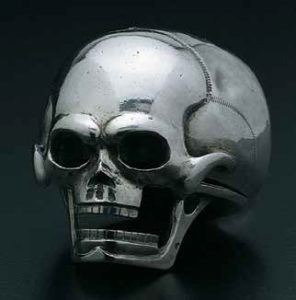
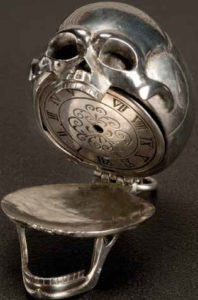
Watch, French, c. 1725– 1750. Marked with French eagle control mark on the pendant. Silver; height 2, width 1 ⅝, depth 1 ¾ inches. Photography by John Bigelow Taylor (left) and Richard Walker (right).
One of the older form watches in the collection is this cast-silver watch modeled as a human skull. Dating from theearly eighteenth century, it is a memento mori—meaning “remember you must die.” The top of the cranium is engraved in a linear pattern that demarcates the sections of the skull. The jaw is hinged and, when opened, reveals a dial with a Roman chapter ring enclosing a scroll design engraved into the underside of the cranium. The taste for skull-shaped watches began in the mid-seventeenth century with Mary, Queen of Scots’ pocket watch. Memento mori timepieces were seen as an encouragement to use your time wisely.
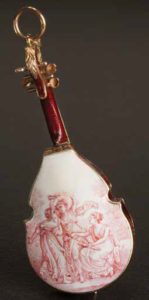
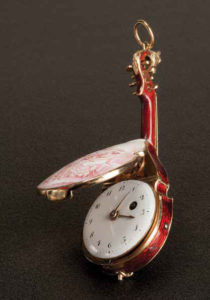
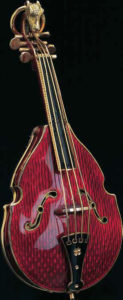 Watch by Carl Wurm, Vienna, Austria, c. 1875–1900. Inscribed “Carl Wurm in Wien, No 307″ on the movement; stamped with Vienna guarantee mark for `872-1922, “A,” and “J*W” for the case maker on the case. Gold and enamel; height 2 ⅝ , width 1, depth ⅝ inch. Photography by Richard Walker.
Watch by Carl Wurm, Vienna, Austria, c. 1875–1900. Inscribed “Carl Wurm in Wien, No 307″ on the movement; stamped with Vienna guarantee mark for `872-1922, “A,” and “J*W” for the case maker on the case. Gold and enamel; height 2 ⅝ , width 1, depth ⅝ inch. Photography by Richard Walker.
In the latter part of the nineteenth century, watches took the guise of musical instruments such as the viola da gamba. The precursor of the modern cello, the viola da gamba produces a sound that is shimmering, quieter that violins, violas, and cellos. The instrument was popular in the fifteenth to eighteenth centuries.
Shakespeare mentions it in Twelfth Night, and the painter Thomas Gainsborough was an avid amateur player.This watch is an accurate miniature of a viola da gamba, with two cutout sound holes and gold strings between the tailing and the scroll in the shape of an animal’s head. A ring is fastened to the end of the scroll so that the watch can be suspended from a chain. The fingerboard is enameled black while the engine-turned grooves in the case suggest the natural wood grain of the body. The reverse depicts a scene with classical muses; the back opens to reveal the watch.
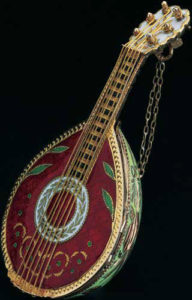
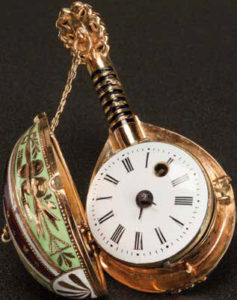
Watch by Gottlieb Wisbach, Regensburg, Austria, c. 1880. Inscribed “Gottlieb Wisbach, Regensburg” on the movement; stamped with the Vienna guarantee mark for 1872-1922 and “K[?]” for the case maker on the case. Gold, enamel; height 2 ½, width 1 ¼, depth 1 inch. Photography by Richard Walker (left) and John Bigelow Taylor (right).
The mandolin was a favorite musical instrument in the nineteenth century. There are many styles of mandolins, but the most common are the carved-top (or archtop), the flat-backed, and the Neapolitan (or round-backed). This mandolin watch is an example of the last type. It has a pear-shaped body and a fingerboard with six metal strings and numerous frets. A gold chain replicates the shoulder strap. The reverse side is decorated with three panels of mint-green enamel engraved with leaves and trophies of music.
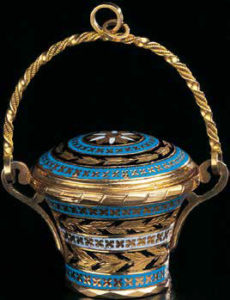
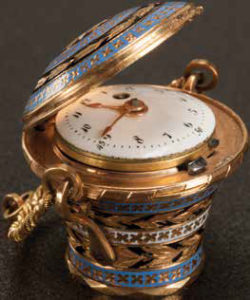 Watch, Swiss, c. 1875-1900. Oxidized silver, gold, enamel; height 1 ½, width 1 ¼, depth 1 inch. Photography by Richard Walker (left) and John Bigelow Taylor (right).
Watch, Swiss, c. 1875-1900. Oxidized silver, gold, enamel; height 1 ½, width 1 ¼, depth 1 inch. Photography by Richard Walker (left) and John Bigelow Taylor (right).
Perhaps an amusing juxtaposition of the luxurious and the quotidian, form watches simulating everyday items were also popular. Ths shape of this watch resembles a basket with a twisted handle of rope or wicker. When a lever is pushed, the hinged lid springs open to reveal a dial with Arabic numbers. the basket is champlevé enameled with bands of engraved gold Xs on a white ground. The gold rim around the bottom is faceted.
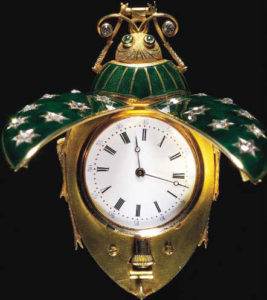
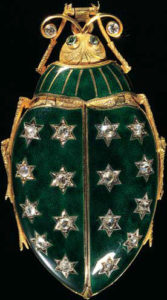
Watch, Swiss, c. 1880-1900. Gold, enamel, diamonds, emeralds, steel, rubies; height 2 ¼, width 1 ¼, depth ¼ inch. Photography by John Bigelow Taylor.
The earliest known use of insect motifs in jewelry are scarab amulets from the Egyptian Middle Kingdom (c. 2000-1786 BC). A romantic interest in naturalism made insects acceptable as design sources in the eighteenth century, then another hundred years elapsed before bejeweled scarabs, woodlice, earwigs, and grasshoppers reemerged on women’s veils and hats of the 1860s.
This watch is in the form of a scarab must have been entertaining to operate: when the lever at the back end is pressed, the scarab’s wings fly open to reveal a dial set into the body. The wings and neck are colored with green translucent enamel, the mottled gold ground producing gradations in the shades. Each wing is set with eight diamonds, each mounted in a star; a cabochon emerald antenna. The gold underside is finished with lifelike fidelity with finely detailed legs and thorax. A hinged pendant ring completes the design.
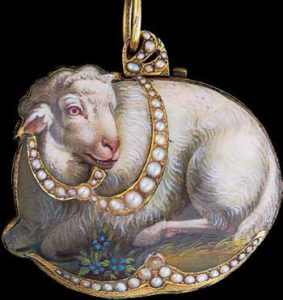
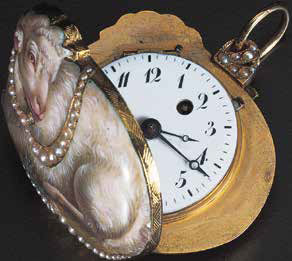 Watch, Swiss, c. 1820. Gold, half-pearls, enamel, steel, silver; height 1 ½, width 1 ½, depth ⅜ inch. Photography by John Bigelow Taylor.
Watch, Swiss, c. 1820. Gold, half-pearls, enamel, steel, silver; height 1 ½, width 1 ½, depth ⅜ inch. Photography by John Bigelow Taylor.
Animals were not a common motif on form watches. This example may have been made especially for a young person. The lamb is depicted resting, its body executed in painted enamel to resemble fleece, with blue flowers at its feet. Half-pearls form the collar circling its neck, the leash attached to the collar, and the framing on the bottom of the case. The reverse shows the lamb’s back, a straw hat filled with fruits and flowers at its feet.
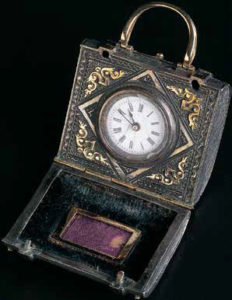
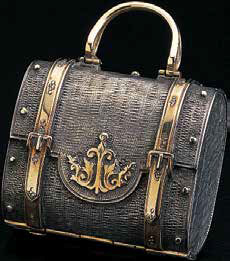 Watch, probably Swiss, c. 1875-1900. Oxidized silver; gold, enamel, steel; height 1 ½, width 1 ¼, depth ¾ inch. Photography by John Bigelow Taylor.
Watch, probably Swiss, c. 1875-1900. Oxidized silver; gold, enamel, steel; height 1 ½, width 1 ¼, depth ¾ inch. Photography by John Bigelow Taylor.
This watch, also meant to be used as a locket, is in the form of a valise and may have once hung from a chatelaine. It is made of oxidized silver that has been worked to replicate the texture and appearance of a woven satchel. Gold straps with buckles, a handle, and fittings complete the valise theme. The inside of the front lid is fitted with a gold frame and glass set into velvet to accommodate either a photograph or a lock of hair. Opposite is a dial set into a lozenge with applied gold scroll motifs at each corner. The back lid opens to enable the wearer to wind the watch and set the time through apertures on the cuvette.
Jewels of Time: Watches from the Proctor Collection, including eighty examples, is on view through April 29 at the Munson-Williams-Proctor Arts Institute Museum of Art, Utica, New York. mwpai.org.
JANET ZAPATA is an independent jewelry historian.
ANNA TOBIN D’AMBROSIO is the president and CEO of the Munson-Williams-Proctor Arts Institute.

